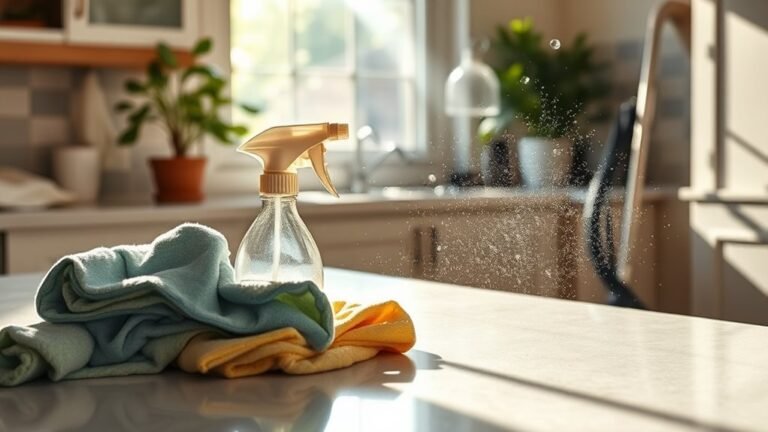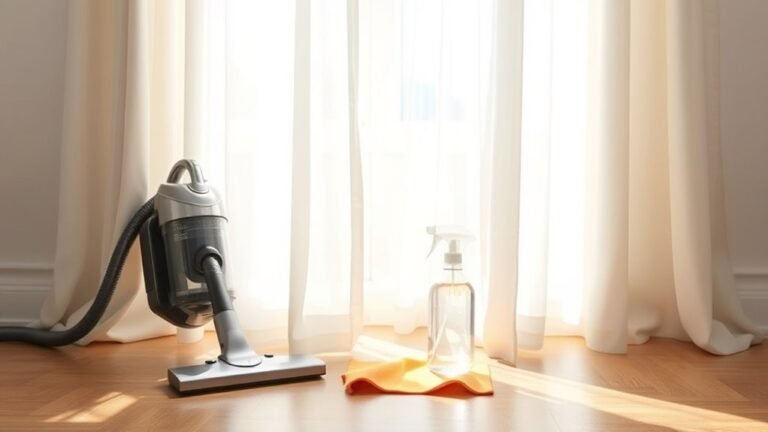Budget-Friendly DIY Cleaning Products for Living Room
You can easily make budget-friendly DIY cleaning products for your living room using simple ingredients like vinegar, baking soda, and essential oils. These natural items clean surfaces, remove odors, and leave your space fresh without harsh chemicals. For example, combine vinegar, water, and essential oils for an all-purpose cleaner or mix olive oil with vinegar for a gentle dusting spray. Keep your living room tidy and inviting while saving money. Keep exploring to find easy recipes and helpful tips for maintaining freshness.
Essential Ingredients for DIY Cleaning Solutions

Although you can find many commercial cleaning products, making your own DIY solutions lets you control the ingredients and avoid harsh chemicals. When crafting your living room cleaner, start with vinegar—its benefits include natural deodorizing and cutting through grime without toxic residues. You’ll appreciate how vinegar tackles dirt while keeping your space fresh. Essential oils are another must-have; not only do they add a pleasant scent, but they also bring antimicrobial properties. Lavender, tea tree, and eucalyptus oils are popular choices that boost your cleaner’s effectiveness and elevate your room’s ambiance. By combining these simple, natural ingredients, you free yourself from reliance on commercial products and embrace a healthier, more eco-friendly lifestyle tailored to your preferences.
All-Purpose Living Room Cleaner Recipe
Creating an all-purpose living room cleaner is simpler than you might think, and it only requires a few basic ingredients you probably already have. This recipe lets you enjoy the all purpose cleaner benefits like versatility and cost savings while embracing eco friendly alternatives that protect your freedom from harsh chemicals. Here’s what you’ll need:
- 1 cup distilled water
- 1 cup white vinegar
- 1 tablespoon baking soda
- 10 drops of your favorite essential oil
Mix these in a spray bottle, starting with water and vinegar, then add baking soda slowly to avoid fizzing over. Add essential oil for a fresh scent. This cleaner tackles dust, spills, and grime, giving you a simple solution that’s safe, effective, and liberates your living space from toxic products.
Natural Dusting Spray for Furniture

You’ll want to start with simple, natural ingredients like water, vinegar, and a few drops of essential oil for a fresh scent. Mixing these properly guarantees your dusting spray cleans effectively without leaving residue. I’ll also share some handy tips to help you apply it smoothly and keep your furniture looking its best.
Key Ingredients Overview
When you want a natural dusting spray for your furniture, choosing the right ingredients is key to both effectiveness and safety. You deserve a cleaning solution that not only protects your beautiful pieces but also respects your budget. Knowing the key benefits of each ingredient helps you mix confidently, creating a product that’s gentle yet powerful. Plus, smart budget considerations mean you won’t break the bank while enjoying a new, toxin-free home.
Here are the essential ingredients to include:
- Distilled water: Purity guarantees no residue or minerals damage your furniture
- White vinegar: Natural disinfectant that cuts through grime and dust
- Essential oils (like lemon or lavender): Add a revitalizing scent and antibacterial properties
- Olive oil: Nourishes wood, preventing cracks and enhancing shine
This combo offers freedom from chemicals and costly cleaners.
Application Tips and Tricks
Although natural dusting sprays are simple to make, applying them correctly guarantees the best results for your furniture. First, always shake the bottle well before use to mix ingredients evenly. Spray lightly onto a microfiber cloth instead of directly on surfaces to avoid over-saturating your wood or fabric. Use gentle, circular cleaning techniques to lift dust without scratching. Pay attention to corners and crevices where dust hides. After dusting, store your spray in a cool, dark place to maintain its freshness and effectiveness. Remember, consistent application not only keeps your living room fresh but also protects furniture from buildup over time. By mastering these tips, you’ll enjoy a cleaner, more vibrant space without hassle or harsh chemicals.
Homemade Upholstery and Fabric Refresher
Since fabrics and upholstery tend to absorb odors and dust over time, having a simple homemade refresher can keep your living room smelling fresh and looking clean without harsh chemicals. You can easily whip up fabric deodorizer recipes that suit your style and freedom to customize scents. These DIY solutions grant you control over what touches your home, avoiding unwanted chemicals while tackling odor and stains effectively.
Try this uplifting mix to refresh your space:
- Baking soda to neutralize odors
- A few drops of your favorite essential oil for a personal touch
- White vinegar for gentle stain lifting
- Water to dilute and safely spray your upholstery
With this, you reclaim your living room’s comfort and beauty on your terms, embracing a cleaner, freer lifestyle.
DIY Glass and Mirror Cleaner

You’ll only need a few simple ingredients like vinegar, water, and a touch of dish soap to make your own glass and mirror cleaner. Mixing them just right guarantees a streak-free shine every time. Plus, I’ll share some easy application tips to help you get the best results quickly.
Ingredients Needed
Three simple ingredients are all you need to make an effective DIY glass and mirror cleaner. This combo gives you the freedom to clean without harsh chemicals while enjoying the vinegar benefits—natural disinfectant and streak-free shine. Baking soda adds gentle scrubbing power to tackle stubborn spots. Here’s what you’ll gather:
- White vinegar for its amazing cleaning strength and natural deodorizing power
- Baking soda to lift grime without scratching surfaces
- Water to dilute and balance the mixture for safe use
- Optional: a few drops of essential oil for a revitalizing scent
With these easy ingredients, you’re in control, saving money and avoiding toxins. It’s your path to a sparkling living room that feels fresh and free.
Application Tips
Start by spraying the DIY cleaner evenly onto the glass or mirror surface. Use a microfiber cloth or a lint-free paper towel to wipe in gentle, circular motions—this prevents streaks and keeps your surfaces crystal clear. For stubborn spots, apply a little extra cleaner and let it sit for a minute before wiping. Remember, mastering these cleaning techniques makes the process quick and effective, giving you more freedom to enjoy your space. After use, verify proper product storage by keeping your cleaner in a well-labeled spray bottle, stored in a cool, dry place away from direct sunlight. This preserves the solution’s effectiveness and keeps it ready for your next cleaning session. With these tips, you’ll maintain sparkling mirrors and glass effortlessly, without breaking the bank.
Stain Removal Techniques Using Common Household Items
When dealing with stubborn stains in your living room, common household items like vinegar, baking soda, and lemon juice can be surprisingly effective. You don’t need expensive products to reclaim your space. These stain removal methods empower you to tackle messes on your terms, using what you already have.
- Mix baking soda and water into a paste to lift tough spots without harsh chemicals.
- Dab vinegar on ink or wine stains to break down pigments naturally.
- Use lemon juice on rust or grease stains for a fresh, eco-friendly cleanse.
- Sprinkle baking soda on fabric, let it sit, then vacuum to refresh upholstery effortlessly.
Embracing these household item effectiveness tricks gives you freedom from costly cleaners and control over your living room’s cleanliness.
Odor Eliminators Made From Pantry Staples
After tackling stains with simple kitchen ingredients, you might want to address lingering odors that can make your living room less inviting. Luckily, pantry staples like baking soda and vinegar come to the rescue. Baking soda benefits extend beyond baking—it’s a powerful odor absorber. Sprinkle it on carpets, let it sit for 15 minutes, then vacuum to neutralize smells. Vinegar uses are just as handy; mix equal parts water and white vinegar in a spray bottle and lightly mist the air or upholstery. The vinegar scent fades quickly, leaving freshness behind. These natural solutions give you freedom from harsh chemicals while keeping your living room smelling clean and welcoming. You don’t need fancy products—your pantry already holds the key to fresh living spaces.
Tips for Maintaining a Clean and Fresh Living Room
Though it can feel like a constant battle, keeping your living room clean and fresh doesn’t have to be overwhelming. By creating a simple cleaning schedule, you can take control without stress, making your space a true retreat. Embrace decluttering tips that free your mind and surroundings, letting you breathe easier every day. Here are some quick ways to maintain that fresh vibe:
- Set a weekly cleaning schedule to stay consistent without pressure.
- Use natural DIY products to keep air and surfaces fresh.
- Declutter daily by putting away items immediately—small steps add up.
- Open windows regularly to invite fresh air and chase stale odors away.
With these habits, your living room will feel inviting, freeing you to relax and enjoy your space fully.
Frequently Asked Questions
Can DIY Cleaners Damage Delicate Living Room Surfaces?
You might worry that DIY cleaners could damage delicate living room surfaces, and that’s a valid concern. Your cleaning effectiveness depends on choosing ingredients compatible with the materials you’re treating. If you don’t check surface compatibility, you risk harming finishes or textures. But when you tailor your DIY solutions carefully, you get both powerful cleaning and freedom to care for your space without harsh chemicals ruining your furniture or décor.
How Long Do Homemade Cleaning Products Last When Stored?
How long do you really expect homemade cleaning products to last when stored? Typically, their shelf life ranges from one week to a few months, depending on ingredients. To maximize freshness, keep them in airtight containers away from heat and sunlight. Don’t forget to label them with the date you made them. With these storage tips, you get freedom to clean confidently without worrying about expired mixtures or wasted effort.
Are These DIY Cleaners Safe for Pets and Children?
You’ll find that many DIY cleaners are gentler than commercial ones, boosting both pet safety and child safety. Still, you’ve got to be cautious—some ingredients like essential oils or vinegar can irritate sensitive noses or paws. Always store your homemade solutions out of reach and test small areas first. This way, you keep your space fresh and safe, giving you the freedom to enjoy a clean home without worry.
Can I Use Essential Oils in All DIY Cleaning Recipes?
You can use essential oils in many DIY cleaning recipes because of their essential oil benefits, like natural fragrance and antibacterial properties. But you shouldn’t add them to every recipe, especially if it involves surfaces that might get damaged or if pets and kids are around. Some oils can be irritating or toxic in large amounts. So, always research the specific oil and recipe before mixing to keep your home safe and fresh.
What’S the Best Way to Test a New Cleaner on Furniture?
When you’re trying out a new cleaner on your furniture, always start with a test patch. Pick a small, hidden spot on the furniture materials to apply a bit of the cleaner. This way, you can see how it reacts without risking any damage. If it doesn’t cause discoloration or damage after a few minutes, you’re good to go. Testing first gives you the freedom to clean confidently without worry.






